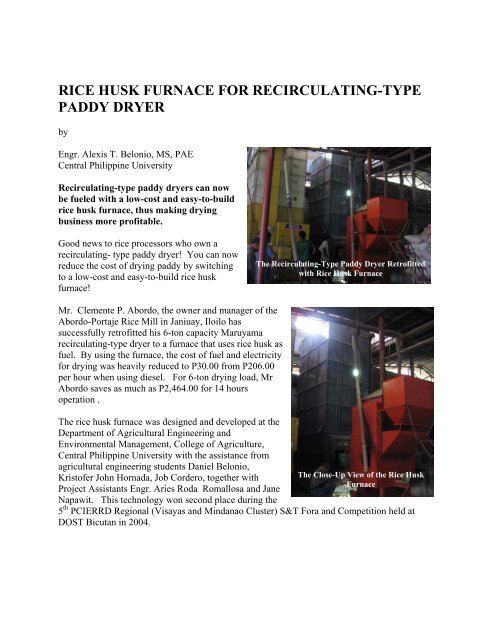rice husk furnace for recirculating-type paddy dryer - BioEnergy ...
rice husk furnace for recirculating-type paddy dryer - BioEnergy ...
rice husk furnace for recirculating-type paddy dryer - BioEnergy ...
- No tags were found...
Create successful ePaper yourself
Turn your PDF publications into a flip-book with our unique Google optimized e-Paper software.
RICE HUSK FURNACE FOR RECIRCULATING-TYPEPADDY DRYERbyEngr. Alexis T. Belonio, MS, PAECentral Philippine UniversityRecirculating-<strong>type</strong> <strong>paddy</strong> <strong>dryer</strong>s can nowbe fueled with a low-cost and easy-to-build<strong>rice</strong> <strong>husk</strong> <strong>furnace</strong>, thus making dryingbusiness more profitable.Good news to <strong>rice</strong> processors who own a<strong>recirculating</strong>- <strong>type</strong> <strong>paddy</strong> <strong>dryer</strong>! You can nowreduce the cost of drying <strong>paddy</strong> by switchingto a low-cost and easy-to-build <strong>rice</strong> <strong>husk</strong><strong>furnace</strong>!The Recirculating-Type Paddy Dryer Retrofittedwith Rice Husk FurnaceMr. Clemente P. Abordo, the owner and manager of theAbordo-Portaje Rice Mill in Janiuay, Iloilo hassuccessfully retrofitted his 6-ton capacity Maruyama<strong>recirculating</strong>-<strong>type</strong> <strong>dryer</strong> to a <strong>furnace</strong> that uses <strong>rice</strong> <strong>husk</strong> asfuel. By using the <strong>furnace</strong>, the cost of fuel and electricity<strong>for</strong> drying was heavily reduced to P30.00 from P206.00per hour when using diesel. For 6-ton drying load, MrAbordo saves as much as P2,464.00 <strong>for</strong> 14 hoursoperation .The <strong>rice</strong> <strong>husk</strong> <strong>furnace</strong> was designed and developed at theDepartment of Agricultural Engineering andEnvironmental Management, College of Agriculture,Central Philippine University with the assistance fromagricultural engineering students Daniel Belonio,Kristofer John Hornada, Job Cordero, together withProject Assistants Engr. Aries Roda Romallosa and JaneNapawit. This technology won second place during theThe Close-Up View of the Rice HuskFurnace5 th PCIERRD Regional (Visayas and Mindanao Cluster) S&T Fora and Competition held atDOST Bicutan in 2004.
The <strong>furnace</strong> is an inclined-grate <strong>type</strong> that uses¼-hp 3-in. diameter electric blower to aid inthe proper combustion of fuel. The fuel is fedinto the hopper that can handle about 2 to 3sacks of <strong>rice</strong> <strong>husk</strong> per load. Feeding of fuelinto the combustion chamber is done througha manually operated damper. The <strong>furnace</strong>has a combustion chamber of 36 cubic feetand burns <strong>rice</strong> <strong>husk</strong> at a temperature of about400 to 700 C. Rice <strong>husk</strong> consumption is only3 to 3.5 sacks per hour. Clean hot air isreceived by the <strong>dryer</strong> from the <strong>furnace</strong> using afired-tube heat exchanger, which is made of12 pieces 3-in. diameter by 2-ft high schedule 40 GI pipes. Burning of fuel is regulated by abellow-<strong>type</strong> thermostat, which maintains the desired drying temperature <strong>for</strong> the <strong>dryer</strong> of 55-80 C.A 12-in. diameter axial fan is used to push the heated air from the heat exchanger to the plenumchamber of the <strong>dryer</strong>. Burned <strong>rice</strong> <strong>husk</strong>, which is in the <strong>for</strong>m of char, are discharged from the<strong>furnace</strong> through a damper and a screw feeder. Paddy with 26-27 % initial moisture content canbe reduced to 14-15% <strong>for</strong> a period of 14 to 15 hours. At 22 to 24% initial moisture content, the<strong>paddy</strong> can be dried to 14-15% final moisture within 8 to 9 hours drying.The <strong>furnace</strong> was built on-site by Mr. Abordo’s two shop welders within a period of one monthwith a total cost of P160,000.00. Cost analysis showed that the investment cost <strong>for</strong> the <strong>furnace</strong>can be recovered in just two and a half months.Mr Abordo uses the <strong>furnace</strong> as the source of heat <strong>for</strong> the <strong>dryer</strong> and, the <strong>rice</strong> hull char produced assoil conditioner <strong>for</strong> his <strong>rice</strong> farm and additive <strong>for</strong> his proposed composting business.Interested <strong>rice</strong> millers or individuals, who wish to adopt this technology, may contact the ProjectDirector, Appropriate Technology Center, Department of Agricultural Engineering andEnvironmental Management, College of Agriculture, Central Philippine University, Iloilo City,Philippines. 033-3291971 loc 1071, Email: atbelonio@yahoo.com, Cell: 09167115222.1 US$ = 50 PHPThe Operation of the Furnace Showing theBurning Rice Husk
















